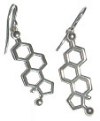Hydrogen fuel cells have been relatively neglected through insufficient support from industry and government, according to a study published today funded by the Economic and Social Research Council (ESRC).
‘Fuel cells are a genuine ‘clean’ technology,’ says study investigators, Chris Hendry of the Cass Business School, London, ‘But re-investment in nuclear technology is likely to squeeze out the investment necessary to make fuel cells competitive with existing energy sources and with other non-nuclear alternative energy options.’
I asked him about the true “cleanness” of fuel cells in the light of new infrastructure requirements, sourcing the requisite hydrogen and the recycling of equipment past its use by date.
“The ideal is to produce the hydrogen by electrolysis, using another renewable source,” he told Sciencebase, “Wind action in particular is intermittent – so when there’s too much generating electricity that can’t be used, it can be diverted to produce the hydrogen. Other countries can use solar for this purpose.”
But, what about sourcing that hydrogen before such technologies are fully viable?
“In the short-term, however, you’re right, the hydrogen will come from other hydrocarbons, particularly natural gas,” he adds, “This will enable fuel cells to become established using existing infrastructure, while a hydrogen infrastructure is developed.”
“In the end, the question is, which energy source has the most efficient
‘well-to-wheels’ costs, and which has also the least recycling costs?”
The study, co-written by Prof. Hendry, Dr. Paul Harborne, James Brown and Prof. Dinos Arcoumanis, gives a strong clue to one of the major obstacles to development by referring to fuel cell technology as a disruptive innovation. A disruptive innovation, if successful, eventually overturns the existing product on the market. Recent examples include the digital camera and the compact disc. Disruptive innovations are radically different from the existing dominant technology and to begin with they are often not as good. The result is two-fold. First the proponents of existing technology are likely to fear and so resist the new development. Second, because profits are unlikely to be immediate, funding can be problematic.
The automotive industry and stationary power provide examples of fuel cells as a disruptive innovation. However, while their potential is being pursued in the UK, Germany, North America and Japan, interviews with seventy companies in these countries show the UK fuel cell industry is lagging behind.
 Precious jewelry is usually made with metals rather than molecules, although there is plenty of costume jewelry made with polymers and other materials which are of course composed of molecules. But, that’s not really a concern for madewithmolecules.com who are touting a chemically aware range of chokers, keychains, necklaces, charm bracelets, and even boxer shorts, sporting your favourite molecule.
Precious jewelry is usually made with metals rather than molecules, although there is plenty of costume jewelry made with polymers and other materials which are of course composed of molecules. But, that’s not really a concern for madewithmolecules.com who are touting a chemically aware range of chokers, keychains, necklaces, charm bracelets, and even boxer shorts, sporting your favourite molecule. Cranberries have a special place in modern herbal folklore, the presence of antioxidant flavonoids in these tart but edible berries are thought to have antimicrobial activity. Now, US researchers have demonstrated that the extracts of the red fruit can prevent Streptococcus mutans, the bacterium responsible for dental caries, from having its wicked way with your teeth and so potentially halt tooth decay.
Cranberries have a special place in modern herbal folklore, the presence of antioxidant flavonoids in these tart but edible berries are thought to have antimicrobial activity. Now, US researchers have demonstrated that the extracts of the red fruit can prevent Streptococcus mutans, the bacterium responsible for dental caries, from having its wicked way with your teeth and so potentially halt tooth decay. Dumb materials succumb to rust, but smart materials might be able to heal themselves.
Dumb materials succumb to rust, but smart materials might be able to heal themselves.
 Plastic waste is a mess. Disposal in landfill is the worst option but recycling post-consumer plastic waste presents a technological nightmare given the huge range of polymers used in packaging and products. A rapid, online method of identifying the different plastics in a recycling stream would provide a way to sort them and allow recycling plants to operate far more efficiently and perhaps make plastic recycling commercially viable.
Plastic waste is a mess. Disposal in landfill is the worst option but recycling post-consumer plastic waste presents a technological nightmare given the huge range of polymers used in packaging and products. A rapid, online method of identifying the different plastics in a recycling stream would provide a way to sort them and allow recycling plants to operate far more efficiently and perhaps make plastic recycling commercially viable.